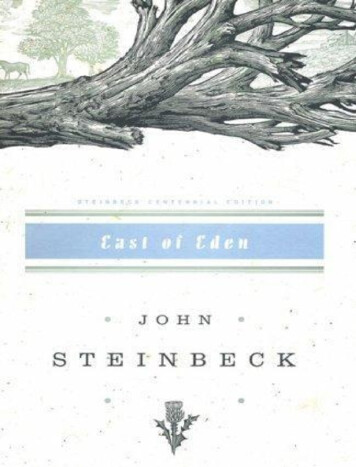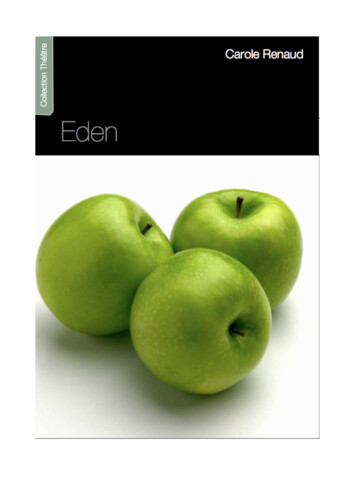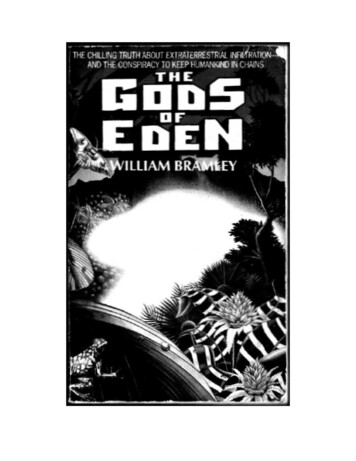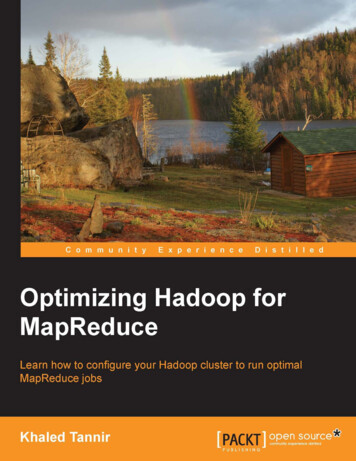
Transcription
EASTOF EDENJOHNSTEINBECK
PENGUIN BOOKSPenguin Books Ltd, Harmondsworth,Middlesex, EnglandPenguin Books, 625 Madison Avenue,New York, New York 10022, U.S.A.Penguin Books Australia Ltd, Ringwood,Victoria, AustraliaPenguin Books Canada Limited, 2801 JohnStreet,Markham, Ontario, Canada L3R 1B4Penguin Books (N.Z.) Ltd, 182-190 WairauRoad,Auckland 10, New ZealandFirst published in the United States ofAmerica byThe Viking Press 1952First published in Canada by The Macmillan
Company ofCanada Limited 1952Viking Compass Edition published 1970Reprinted 1974Published in Penguin Books 1979Copyright 1952 by John SteinbeckAll rights reservedLIBRARY OF CONGRESSCATALOGING IN PUBLICATION DATASteinbeck, John, 1902-1968.East of Eden.I. Title.[PZ3.S8195Eas 1979] [PS3537.T3234]813’.5’2 79-14915ISBN 0 14 00.4997 5Printed in the United States of America by
Offset Paperback Mfrs., Inc., Dallas,PennsylvaniaSet in Times RomanExcept in the United States of America,this book is sold subject to the conditionthat it shall not, by way of trade or otherwise,be lent, re-sold, hired out, or otherwisecirculatedwithout the publisher’s prior consent in anyform ofbinding or cover other than that in which it ispublished and without a similar conditionincluding this condition being imposedon the subsequent purchaser
Table ofContentsLetter to Pascal CoviciPart OneChapter 1Chapter 2Chapter 3
Chapter 4Chapter 5Chapter 6Chapter 7Chapter 8Chapter 9Chapter 10Chapter 11Part TwoChapter 12Chapter 13Chapter 14
Chapter 15Chapter 16Chapter 17Chapter 18Chapter 19Chapter 20Chapter 21Chapter 22Part ThreeChapter 23Chapter 24Chapter 25
Chapter 26Chapter 27Chapter 28Chapter 29Chapter 30Chapter 31Chapter 32Chapter 33Part FourChapter 34Chapter 35Chapter 36
Chapter 37Chapter 38Chapter 39Chapter 40Chapter 41Chapter 42Chapter 43Chapter 44Chapter 45Part FiveChapter 46Chapter 47
Chapter 48Chapter 49Chapter 50Chapter 51Chapter 52Chapter 53Chapter 54Chapter 55
PASCAL COVICIDear Pat,You came upon mecarving some kind of littlefigure out of wood and yousaid, “Why don’t you makesomething for me?”I asked you what youwanted, and you said, “Abox.”“What for?”“To put things in.”
“What things?”“Whatever you have,”you said.Well, here’s your box.Nearly everything I have is init, and it is not full. Pain andexcitement are in it, andfeeling good or bad and evilthoughts and good thoughts—the pleasure of design andsome despair and theindescribable joy of creation.And on top of these are
all the gratitude and love Ihave for you.And still the box is notfull.JOHN
PART ONE
Chapter 11The Salinas Valley is inNorthern California. It is along narrow swale betweentwo ranges of mountains, andthe Salinas River winds andtwists up the center until itfalls at last into MontereyBay.
Iremembermychildhood names for grassesandsecretflowers.Iremember where a toad maylive and what time the birdsawaken in the summer—andwhat trees and seasonssmelled like—how peoplelooked and walked andsmelled even. The memory ofodors is very rich.I remember that theGabilan Mountains to the east
of the valley were light gaymountains full of sun andloveliness and a kind ofinvitation, so that you wantedto climb into their warmfoothills almost as you wantto climb into the lap of abeloved mother. They werebeckoning mountains with abrown grass love. The SantaLucias stood up against thesky to the west and kept thevalley from the open sea, andthey were dark and brooding
—unfriendly and dangerous. Ialways found in myself adread of west and a love ofeast. Where I ever got such anidea I cannot say, unless itcould be that the morningcame over the peaks of theGabilans and the night driftedback from the ridges of theSanta Lucias. It may be thatthe birth and death of the dayhad some part in my feelingabout the two ranges ofmountains.
From both sides of thevalley little streams slippedout of the hill canyons andfell into the bed of the SalinasRiver. In the winter of wetyears the streams ran fullfreshet, and they swelled theriver until sometimes it ragedand boiled, bank full, andthen it was a destroyer. Theriver tore the edges of thefarm lands and washed wholeacres down; it toppled barnsand houses into itself, to go
floating and bobbing away. Ittrapped cows and pigs andsheep and drowned them inits muddy brown water andcarried them to the sea. Thenwhen the late spring came,the river drew in from itsedges and the sand banksappeared. And in the summerthe river didn’t run at allabove ground. Some poolswould be left in the deepswirl places under a highbank. The tules and grasses
grew back, and willowsstraightened up with the flooddebrisintheirupperbranches. The Salinas wasonly a part-time river. Thesummersundroveitunderground. It was not a fineriver at all, but it was the onlyone we had and so weboastedaboutit—howdangerous it was in a wetwinter and how dry it was ina dry summer. You can boastabout anything if it’s all you
have. Maybe the less youhave, the more you arerequired to boast.The floor of the SalinasValley, between the rangesand below the foothills, islevel because this valley usedto be the bottom of ahundred-mile inlet from thesea. The river mouth at MossLanding was centuries agothe entrance to this longinland water. Once, fifty
miles down the valley, myfather bored a well. The drillcame up first with topsoil andthen with gravel and thenwith white sea sand full ofshells and even pieces ofwhalebone.Thereweretwenty feet of sand and thenblack earth again, and even apiece of redwood, thatimperishable wood that doesnot rot. Before the inland seathe valley must have been aforest. And those things had
happened right under our feet.And it seemed to mesometimes at night that Icould feel both the sea andthe redwood forest before it.On the wide level acresof the valley the topsoil laydeep and fertile. It requiredonly a rich winter of rain tomake it break forth in grassand flowers. The springflowers in a wet year wereunbelievable. The whole
valley floor, and the foothillstoo, would be carpeted withlupins and poppies. Once awoman told me that coloredflowers would seem morebright if you added a fewwhite flowers to give thecolors definition. Every petalof blue lupin is edged withwhite, so that a field of lurinsis more blue than you canimagine. And mixed withthese were splashes ofCalifornia poppies. These too
are of a burning color—notorange, not gold, but if puregold were liquid and couldraise a cream, that goldencream might be like the colorof the poppies. When theirseason was over the yellowmustard came up and grew toa great height. When mygrandfather came into thevalley the mustard was so tallthat a man on horsebackshowed only his head abovethe yellow flowers. On the
uplands the grass would bestrewn with buttercups, withhen-and-chickens, with blackcentered yellow violets. Anda little later in the seasonthere would be red andyellow stands of Indianpaintbrush. These were theflowers of the open placesexposed to the sun.Under the live oaks,shaded and dusky, themaidenhair flourished and
gave a good smell, and underthe mossy banks of the watercourses whole clumps of fivefingered ferns and goldybacks hung down. Then therewere harebells, tiny lanterns,cream white and almost sinfullooking, and these were sorare and magical that a child,finding one, felt singled outand special all day long.When June came thegrasses headed out and turned
brown, and the hills turned abrown which was not brownbut a gold and saffron and red—an indescribable color. Andfrom then on until the nextrains the earth dried and thestreams stopped. Cracksappeared on the level ground.The Salinas River sank underits sand. The wind blew downthe valley, picking up dustand straws, and grew strongerand harsher as it went south.It stopped in the evening. It
was a rasping nervous wind,and the dust particles cut intoa man’s skin and burned hiseyes. Men working in thefields wore goggles and tiedhandkerchiefs around theirnoses to keep the dirt out.The valley land wasdeep and rich, but thefoothills wore only a skin oftopsoil no deeper than thegrass roots; and the farther upthe hills you went, the thinner
grew the soil, with flintssticking through, until at thebrush line it was a kind of dryflinty gravel that reflected thehot sun blindingly.I have spoken of the richyears when the rainfall wasplentiful. But there were dryyears too, and they put aterror on the valley. Thewater came in a thirty-yearcycle. There would be five orsix wet and wonderful years
when there might be nineteento twenty-five inches of rain,and the land would shout withgrass. Then would come sixor seven pretty good years oftwelve to sixteen inches ofrain. And then the dry yearswould come, and sometimesthere would be only seven oreight inches of rain. The landdried up and the grassesheaded out miserably a fewinches high and great barescabby places appeared in the
valley. The live oaks got acrusty look and the sagebrushwas gray. The land crackedand the springs dried up andthe cattle listlessly nibbleddry twigs. Then the farmersand the ranchers would befilled with disgust for theSalinas Valley. The cowswould grow thin andsometimes starve to death.People would have to haulwater in barrels to their farmsjust for drinking. Some
families would sell out fornearly nothing and moveaway. And it never failed thatduring the dry years thepeople forgot about the richyears, and during the wetyears they lost all memory ofthe dry years. It was alwaysthat way.2And that was the long Salinas
Valley. Its history was likethat of the rest of the state.First there were Indians, aninferior breed without energy,inventiveness, or culture, apeople that lived on grubs andgrasshoppers and shellfish,too lazy to hunt or fish. Theyate what they could pick upand planted nothing. Theypounded bitter acorns forflour. Even their warfare wasa weary pantomime.
Then the hard, drySpaniards came exploringthrough, greedy and realistic,and their greed was for goldor God. They collected soulsas they collected jewels. Theygatheredmountainsandvalleys, rivers and wholehorizons, the way a manmight now gain title tobuilding lots. These tough,dried-upmenmovedrestlessly up the coast anddown. Some of them stayed
on grants as large asprincipalities, given to themby Spanish kings who had notthe faintest idea of the gift.These first owners lived inpoor feudal settlements, andtheir cattle ranged freely andmultiplied. Periodically theowners killed the cattle fortheir hides and tallow and leftthe meat to the vultures andcoyotes.When the Spaniards
came they had to giveeverything they saw a name.This is the first duty of anyexplorer—a duty and aprivilege. You must name athing before you can note iton your hand-drawn map. Ofcourse they were religiouspeople, and the men whocould read and write, whokept the records and drew themaps, were the tough untiringpriests who traveled with thesoldiers. Thus the first names
of places were saints’ namesorreligiousholidayscelebrated at stopping places.There are many saints, butthey are not inexhaustible, sothat we find repetitions in thefirst namings. We have SanMiguel, St. Michael, SanArdo, San Bernardo, SanBenito, San Lorenzo, SanCarlos, San Francisquito. Andthen the holidays—Natividad,the Nativity; Nacimiente, theBirth; Soledad, the Solitude.
But places were also namedfrom the way the expeditionfelt at the time: BuenaEsperenza, good hope; BuenaVista because the view wasbeautiful;andChualarbecause it was pretty. Thedescriptive names followed:Paso de los Robles because ofthe oak trees; Los Laurelesfor the laurels; Tularcitosbecause of the reeds in theswamp; and Salinas for thealkali which was white as
salt.Then places were namedfor animals and birds seen—Gabilanes for the hawkswhichflewinthosemountains; Topo for themole; Los Gatos for the wildcats.Thesuggestionssometimes came from thenature of the place itself:Tassajara, a cup and saucer;Laguna Seca, a dry lake;Corral de Tierra for a fence of
earth; Paraiso because it waslike Heaven.Then the Americanscame—more greedy becausethere were more of them.They took the lands, remadethe laws to make their titlesgood. And farmholds spreadover the land, first in thevalleys and then up thefoothill slopes, small woodenhouses roofed with redwoodshakes, corrals of split poles.
Wherever a trickle of watercame out of the ground ahouse sprang up and a familybegan to grow and multiply.Cuttings of red geraniumsand rosebushes were plantedin the dooryards. Wheeltracks of buckboards replacedthe trails, and fields of cornand barley and wheat squaredout of the yellow mustard.Every ten miles along thetraveled routes a general storeandblacksmithshop
happened, and these becamethe nuclei of little towns,Bradley,KingCity,Greenfield.The Americans had agreater tendency to nameplaces for people than had theSpanish. After the valleyswere settled the names ofplaces refer more to thingswhich happened there, andthese to me are the mostfascinating of all names
because each name suggests astory that has been forgotten.I think of Bolsa Nueva, a newpurse; Morocojo, a lameMoor (who was he and howdid he get there?); WildHorse Canyon and MustangGrade and Shirt Tail Canyon.The names of places carry acharge of the people whonamed them, reverent orirreverent, descriptive, eitherpoetic or disparaging. Youcan name anything San
Lorenzo, but Shirt TailCanyon or the Lame Moor issomething quite different.The wind whistled overthe settlements in theafternoon, and the farmersbegan to set out mile-longwindbreaks of eucalyptus tokeep the plowed topsoil fromblowing away. And this isabout the way the SalinasValley was when mygrandfather brought his wife
and settled in the foothills tothe east of King City.
Chapter 21I must depend on hearsay, onold photographs, on storiestold, and on memories whichare hazy and mixed with fablein trying to tell you about theH
OF EDEN JOHN STEINBECK. PENGUIN BOOKS Penguin Books Ltd, Harmondsworth, Middlesex, England Penguin Books, 625 Madison Avenue, New York, New York 10022, U.S.A. Penguin Books Australia Ltd, Ringwood, Victoria, Australia Penguin Books Canada Limited, 2801 John Street, Markham, Ontario, Canada L3R 1B4 Penguin Books (N.Z.) Ltd, 182-190 Wairau Road, Auckland 10, New











